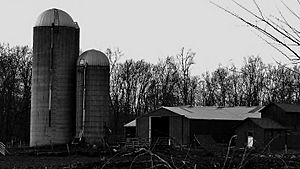Silo facts for kids
A silo is a building that holds silage. Silage is green chopped plants (usually grass or corn stalks) that is kept wet (this is different than hay, which is stored dry). It ferments and can be kept all winter. It makes good food for livestock, particularly dairy cows.
Contents
History
The silo is a fairly recent part of the farmyard. It was first widely used in the late 1800's. They are still used today.
Structure
While silage can be stored in many ways, the typical silo is a tall cylinder. It usually has a cone or dome cap on top. There is an opening at the top to put silage in, and doors running down one side to take it out. Originally a farmer would climb the outside of the silo to the top of the silage, go inside, and shovel out the silage. There is typically a chute on the outside, and the silage would fall down the chute, where it could be gathered and fed to the cows. Now there is machinery that does that job.
Images for kids
-
Steel grain bins in Ralls, Texas, United States.
-
Grain elevators are composed of groups of grain silos such as these at Port Giles, South Australia.
-
Silos in Acatlán, Hidalgo, Mexico.
-
This bin contains 27 variations of stone, sand and gravel, Copenhagen, Denmark
-
Ancient Greek vases shaped as grain silos, 700/650 BC, Kerameikos Archaeological Museum, Athens.
-
Silo 3.5 miles southeast of Blooming Grove, Texas, built ca. 1900 by F. B. Cumpston. Used mainly for corn.
-
The Swissmill Tower in Zürich (Switzerland) is the world highest silo.
-
Three types of wheat bins, Delungra, New South Wales.
-
Percy Hobson Park water tower, Bourke, New South Wales, Australia (2021).
-
Thallon, Queensland, Australia (2021).
-
Yelarbon, Queensland, Australia (2019).
-
Coonalpyn, South Australia, Australia (2018).
-
Kantola Biscuit Factory, Hämeenlinna, Finland (2019).
See also
 In Spanish: Silo para niños
In Spanish: Silo para niños

























